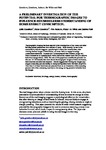A preliminary investigation of the potential for thermographic images to influence householders' understanding of home energy consumption
| dc.contributor.author | Auburn, Timothy | |
| dc.contributor.author | Goodhew, Julie | |
| dc.contributor.author | Goodhew, Steve | |
| dc.contributor.author | de Wilde, Pieter | |
| dc.contributor.author | Pahl, Sabine | |
| dc.contributor.editor | Dainty B | |
| dc.date.accessioned | 2016-01-04T15:52:57Z | |
| dc.date.available | 2016-01-04T15:52:57Z | |
| dc.date.issued | 2009-12-01 | |
| dc.identifier.isbn | 095523901X | |
| dc.identifier.isbn | 9780955239014 | |
| dc.identifier.uri | http://hdl.handle.net/10026.1/4162 | |
| dc.description.abstract |
This paper explores the potential connections between the thermographic (infrared) imaging of domestic properties and the impact (on energy conservation behaviours) of showing householders infrared images of their homes. Infrared (IR) images, or thermographic imaging, as it has become known has been applied to the investigation of heat losses and other building related phenomena such as moisture penetration of roofs and failures in damp-proofing systems for a number of years. Recently it has been used by a wide range of public and private bodies to demonstrate the heat of a home in a visible format. This suggests a connection between the householder viewing an IR image and engaging in energy conservation behaviour, such as installing insulation. It is hypothesised that information presented in a manner which attracts the attention of the intended audience, being vivid, specific and personal, is more likely to achieve behaviour change (Stern, 1992). In this paper the evidence of the thermal characteristic of the dwelling (as shown within the thermographic image) will be compared with the householder’s reasoning process as prompted by viewing the images. The possible increase in energy saving behaviours and changes in related attitudes leading from this intervention will be investigated. Questions concerning the links between the householder’s reactions to the images and the possibility that this may facilitate a reduction in energy consumption will be discussed. | |
| dc.format.extent | 971-979 | |
| dc.language.iso | en | |
| dc.relation.ispartof | Proceedings of ARCOM conference 2009 | |
| dc.title | A preliminary investigation of the potential for thermographic images to influence householders' understanding of home energy consumption | |
| dc.type | chapter | |
| plymouth.publication-status | Published | |
| plymouth.organisational-group | /Plymouth | |
| plymouth.organisational-group | /Plymouth/Faculty of Arts, Humanities and Business | |
| plymouth.organisational-group | /Plymouth/Faculty of Arts, Humanities and Business/School of Art, Design and Architecture | |
| plymouth.organisational-group | /Plymouth/Faculty of Health | |
| plymouth.organisational-group | /Plymouth/Faculty of Health/School of Psychology | |
| plymouth.organisational-group | /Plymouth/REF 2021 Researchers by UoA | |
| plymouth.organisational-group | /Plymouth/REF 2021 Researchers by UoA/UoA04 Psychology, Psychiatry and Neuroscience | |
| plymouth.organisational-group | /Plymouth/REF 2021 Researchers by UoA/UoA04 Psychology, Psychiatry and Neuroscience/UoA04 Psychology, Psychiatry and Neuroscience MANUAL | |
| plymouth.organisational-group | /Plymouth/REF 2021 Researchers by UoA/UoA13 Architecture, Built Environment and Planning | |
| plymouth.organisational-group | /Plymouth/Research Groups | |
| plymouth.organisational-group | /Plymouth/Research Groups/Centre for Brain, Cognition and Behaviour (CBCB) | |
| plymouth.organisational-group | /Plymouth/Research Groups/Centre for Brain, Cognition and Behaviour (CBCB)/Behaviour | |
| plymouth.organisational-group | /Plymouth/Research Groups/Institute of Health and Community | |
| plymouth.organisational-group | /Plymouth/Users by role | |
| plymouth.organisational-group | /Plymouth/Users by role/Academics | |
| dc.rights.embargoperiod | Not known | |
| rioxxterms.licenseref.uri | http://www.rioxx.net/licenses/all-rights-reserved | |
| rioxxterms.type | Book chapter |


